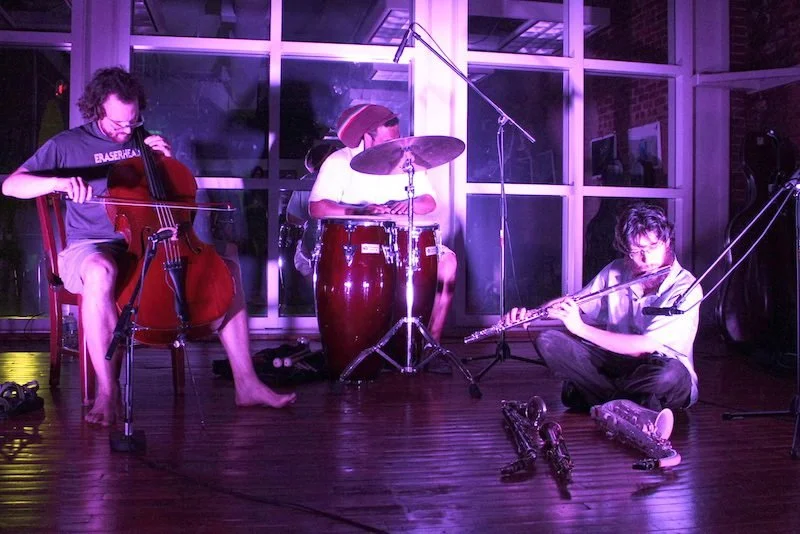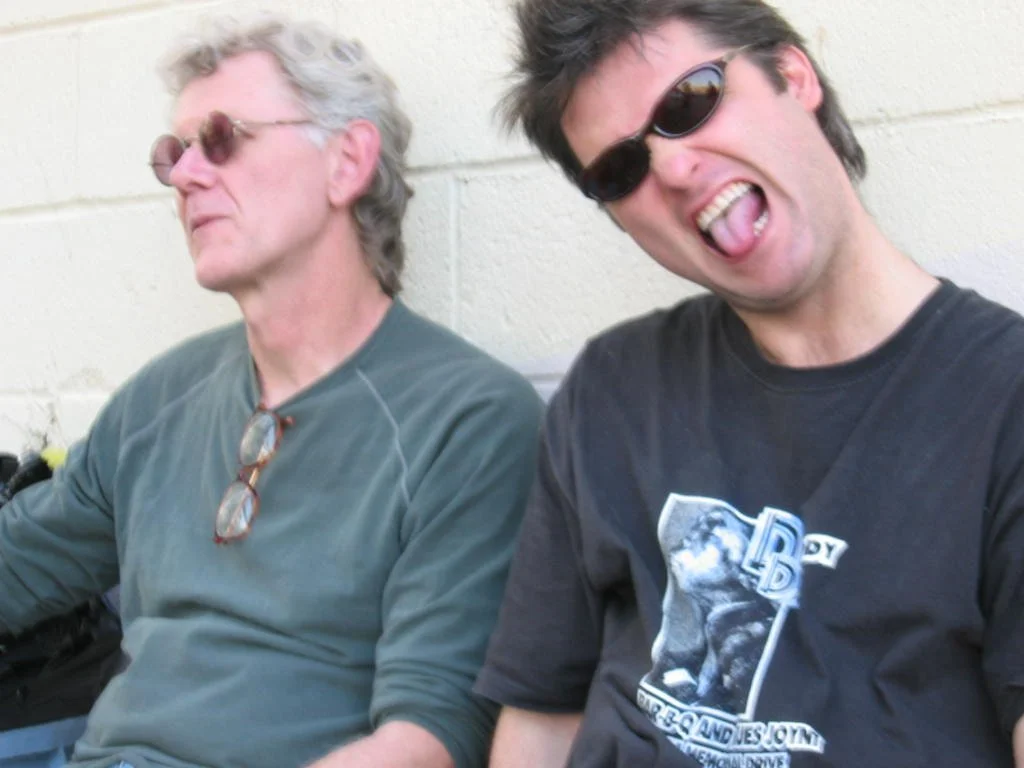Edgy, peripatetic Eyedrum gallery reopens October 16 in new downtown space
Mervyn "Skip" Williamson (August 19, 1944 – March 16, 2017) was an American underground cartoonist and central figure in the underground comix movement. Williamson painted this mural at eyedrum’s MLK location. (Photo by Nisa Asokan)
LOUISE E. SHAW - OCTOBER 14, 2021 for ArtsATL
Elevated trains roar loudly just beyond the courtyard of Eyedrum’s new home on Ralph David Abernathy Boulevard in southwest Atlanta. Since Eyedrum’s founding in 1998 and its moves across downtown’s warehouse and commercial districts, the rhythm of trains has been the bass line of the organization’s soundtrack. Will these current trains sprinkle magic dust over Eyedrum’s new combined gallery and performance space and its covered loading dock that can serve as an outdoor stage? Can the magic that once was Eyedrum be reignited? Eyedrum leaders are working hard and hopefully smart to adapt to an ever-changing cultural landscape, while building on the organization’s historic commitment to cross-discipline experimental and avant-garde arts.
Officially reopening this month, the Eyedrum Art & Music Gallery is partnering with arts-friendly developers David Decker and Stephen Evans of C4 Developers to adapt the 2,700-square-foot open space located in a former auto supply warehouse. After benefiting from the slowdown afforded by the Covid pandemic and weighing all its options, Eyedrum entered into the six-year lease with C4 a year ago. The owners solidified the deal by offering to complete most of the buildout, including new bathrooms and back-of-house spaces. Cash donations of $10,000 and generous in-kind support have paid for additional capital costs. Eyedrum’s neighbors in the complex include an electric scooter company and a gym, and Decker and Evans are planning to convert the second story into artist studios.
The Living Space Trio performed at eyedrum in 2013: Benjamin Shirley on cello, Scotty Bryan on percussion and Eric Fontaine on winds.
Although Eyedrum has quietly been holding small events in the space for the past year, this new chapter in its history will launch on Saturday, October 16, when Ego Te Absolvo, curated by Atlanta-based artist Kirstin Mitchell, opens. A reflection upon our collective Covid experience of isolation and quarantine, the exhibition includes video-based work by artists across the United States and Europe and speaks to Eyedrum’s international ambitions.
Mitchell, who has a long history with Eyedrum and is its first curator-in-residence, sees Eyedrum’s new home as an important moment for the Atlanta arts scene. The project, which includes performances on October 30, has been supported by the Office of Cultural Affairs, City of Atlanta, as part of the 2021 Elevate series. Eyedrum is also launching monthly events, including the open mic Kirkwood Ballers Club and artist critique groups.
The early history
Much has been written about the legendary Eyedrum Art & Music Gallery and its 1997 roots in a second-floor loft on Trinity Street on the edgy outskirts of downtown Atlanta. At the Silver Ceiling, named for the aluminum foil that kept the ceiling intact, Marshall Avett and Woody Cornwell began to present monthly skronk jazz and experimental music and art happenings.
A year later, in 1998, Avett and Cornwell rented the storefront below their loft and christened it Eyedrum to reflect their vision to showcase experimental arts and music. Word spread quickly about the space where there were truly no boundaries. In response to noise complaints, Eyedrum moved in September 2001 from Trinity Street to a warehouse at 290 Martin Luther King Jr. Drive, where its programming and space expanded. After nine years, Eyedrum lost its lease there and in 2010, the warehouse was razed, and the site is now home to one of the omnipresent apartment buildings along the Memorial Drive corridor.
eyedrum’s building on Martin Luther King Jr. Drive
The history of Eyedrum’s ongoing peregrinations through downtown Atlanta are integrated into the story of gentrification of underutilized historic centers and warehouse districts across the United States. The typical plot goes like this: Artists and arts organizations inhabit historic, rundown buildings and warehouses, attracting hipster activity. Developers, ranging from small groups to large real estate companies, get wind of the action and start investing in the areas. The neighborhoods start taking off. Wanting to “brand” their properties, developers welcome artists with low rents. Many are true art supporters. But often, rents start rising; warehouses are torn down for new developments; buildings are converted into high-end real estate. Artists must pay up or move.
Back to 2010: An itinerant Eyedrum began partnering with arts organizations around Atlanta, including the Goat Farm and C4 (not to be confused with Eyedrum’s current landlord). In 2014, the organization moved to a storefront on Forsyth Street in south downtown and was actively working to promote the area as an arts district. A 2018 fire on bordering Broad Street resulted in the current developer, who had acquired 50 properties in the area, evicting tenants occupying the block. Once again, Eyedrum was homeless, although it tried for a while to keep the south downtown art dream alive. It began to hold occasional events around town, including a spectacular 20th anniversary reunion at the Met in 2018. Now, in 2021, Eyedrum is revealing its newest incarnation.
The “anti-organization” organization
Historically, Atlanta has had a thriving underground art ecology fueled by a large grassroots arts community willing to roll up its sleeves. Through the decades, artists have consistently reinvented the Atlanta art scene by creating organizations reflective of the current zeitgeist. Sometimes, these efforts took root and organizations such as Atlanta Contemporary (formerly Nexus) and 7 Stages, both founded in the 1970s, evolved into well-established art institutions. Both, by the way, solved real estate challenges by buying their buildings.
In contrast, for most of its 23 year existence, Eyedrum created its own radical path by choosing NOT to institutionalize and by remaining volunteer driven and managed. No one was more passionate about this philosophical stand than multidisciplinary artist Robert Cheatham, volunteer Eyedrum director from 2003-2010. In a 2011 Creative Loafing interview, he characterized Eyedrum’s organizational model as a “world-class anti-organization organization.” This anti-institutional stance has been the source of Eyedrum’s strength. It also explains why, after 23 years, stability has been somewhat elusive, particularly when coupled with the vagaries of real estate in a rapidly gentrifying city.
Robert Cheatham and Woody Cornwell
When the arts community followed Eyedrum to Martin Luther King Jr. Drive in 2001, the organization became a super-magnet for artists, engineers, web developers, designers, critics, music producers, curators and others who were willing to fully engage in what Cheatham called the Eyedrum “lifestyle.” At the time, if you joined the Eyedrum board, you were expected to work 20 or more hours a week, plus maintain your day job. The energy was bordering on visible, so much so that board member Omar Khalid suggested that “everyone was glowing.” But this energy could also be depleting, resulting in burnout and PTSD.
In the MLK warehouse, which eventually expanded from 3,000 to 6,000 square feet, Eyedrum created programs that shape its current planning. The extensive Eyedrum music program, which ranged from monthly improvisational sessions to evenings of experimental music by global avant garde artists touring the States or Atlanta’s own Bent Frequency. Throw in some punk rock, blues and klezmer, and you get the picture. And remember, these 200-plus a year events were all managed by volunteers.
The art committee, equally busy, curated year-round exhibitions by Atlanta, regional, national and international artists, pushing the envelope of work and ideas. The exhibitions were by definition risky, and some were spectacular, like the 2002 Breadth, a monumental sculpture exhibition that expanded into a neighboring warehouse space. Meanwhile, lectures and writer exchanges abounded. This writer’s favorite program was the Film Love series organized by Andy Ditzler, who curated evenings of historic and contemporary experimental films and provided thoughtful commentaries. Lastly, it’s worth noting that Eyedrum was truly intergenerational and welcoming to all artists and community members.
Keeping the vision alive
Although Eyedrum leaders have tried to recapture that magic since leaving MLK in 2010, it has been challenging, but keepers of the faith have not let the Eyedrum vision extinguish. The current 10-member working board includes members of Eyedrum’s old guard, including Will Lawless and Nisa Asokan, and a new generation of art activists, such as Willow Goldstein. Working to develop an efficient operational framework, Eyedrum states that it “runs on a DIY Ethic Action based in personal and organizational responsibility and accountability” with “respect for all people and all art genres.”
Looking toward building a stable organization, Eyedrum is providing stipends for curators-in-residence, commencing with Kirsten Mitchell. It recently hired part-time development and community relation directors, whose responsibilities include building organizational infrastructure and capacity. Wishing to stop the displacement cycle once and for all, Eyedrum wants to launch a capital campaign to purchase a permanent home to open in time for its 30th anniversary in 2028. That’s a heavy lift for any organization, and particularly for one that has been rich in human capital, but not well-resourced financially.
All organizations, by definition, must evolve. In this new materialization, will Eyedrum attract a younger generation of artists willing to join the movement? Will it reestablish its relevance to the arts community? Can Eyedrum achieve a balance of its historic anarchic energy with a stable arts management structure and sustainable resources? Will Eyedrum develop the capacity to undertake a capital campaign while maintaining its DIY philosophy? These questions no doubt will be addressed in the coming years. In the meantime, I’m anticipating magic this month at Eyedrum and look forward to the roar of trains overhead.
::
Louise E. Shaw has been a cultural worker in Atlanta for over 40 years. She served as executive director of Nexus Contemporary Art Center from 1983-1998, and was on Eyedrum’s ad hoc advisory board in the 2000s.
original story appeared in ArtsATL here: https://www.artsatl.org/edgy-peripatetic-eyedrum-gallery-reopens-october-16-in-new-downtown-space/




